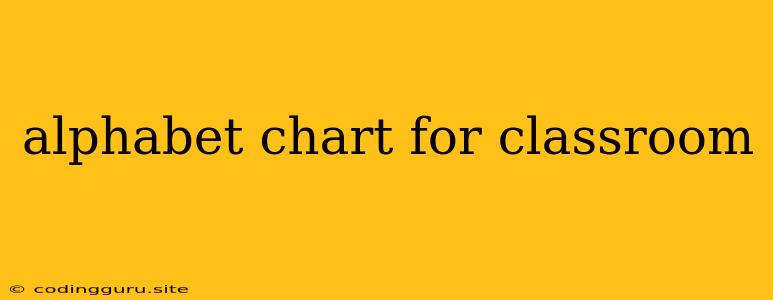Creating an Engaging Alphabet Chart for Your Classroom
An alphabet chart is an essential tool for young learners, serving as a visual reference point for letter recognition, sound awareness, and early reading skills. A well-designed chart can transform your classroom into an interactive and engaging learning environment. But with so many options available, how do you create an alphabet chart that truly captivates your students and supports their learning journey?
Here's a comprehensive guide to help you design an alphabet chart that's perfect for your classroom:
1. Choose the Right Format
- Traditional Chart: The classic, straightforward option. It typically displays the alphabet in uppercase and lowercase letters, often with a picture or illustration representing each letter.
- Interactive Chart: Offers hands-on opportunities for learning. This could include movable letter tiles, pockets for flashcards, or touch-sensitive elements that trigger sounds or animations.
- Thematic Chart: Tailors the alphabet to a specific theme like animals, food, or objects, making learning more engaging and relevant to your students' interests.
2. Prioritize Clarity and Readability
- Font Choice: Opt for clear and legible fonts that are easy for young eyes to recognize. Avoid decorative or overly stylized fonts that can hinder readability.
- Color Scheme: Use a vibrant color scheme that's appealing to children but not overwhelming. Consider using contrasting colors for the letters and the background.
- Layout: Organize the letters in a logical manner, such as alphabetical order. Use ample spacing between letters to prevent crowding and improve visibility.
3. Incorporate Visual Interest
- Images: Choose high-quality images that represent each letter. Ensure the images are relevant to the age and interests of your students and visually appealing.
- Illustrations: Handmade illustrations can add a personal touch and make the chart more unique. Encourage your students to participate in creating their own artwork for the chart.
- Texture: Consider incorporating textured elements, like felt letters, or textured paper for a multi-sensory experience.
4. Make it Interactive
- Manipulatives: Provide manipulatives like letter tiles, counters, or small toys that can be used with the chart for activities like matching, sorting, or building words.
- Games: Design simple games or activities that use the alphabet chart as a central element. Examples include letter bingo, alphabet matching, or alphabet puzzles.
- Touch and Feel: Incorporate elements that invite touch and exploration. For example, you could create a chart with pockets that hold letter shapes for children to trace and feel.
5. Integrate Learning Opportunities
- Phonics: Use the chart to teach phonics skills by highlighting the sounds each letter makes.
- Sight Words: Introduce high-frequency sight words and include them on the chart as they are learned.
- Vocabulary: Connect the images on the chart to vocabulary words and encourage students to use them in sentences.
6. Display the Chart Strategically
- Placement: Locate the chart in a high-traffic area of your classroom where it is easily accessible to all students.
- Lighting: Ensure the chart is well-lit for optimal visibility.
- Height: Mount the chart at a height that allows all students to see it clearly.
7. Adapt and Evolve
- Student Input: Encourage students to contribute ideas for the chart and help you create it.
- Themes: Change the theme of the chart periodically to keep it engaging and fresh.
- Updates: As your students' language skills grow, add more complex elements, such as punctuation or diagraphs.
Example: A Thematic Alphabet Chart
Theme: Farm Animals
Layout: The alphabet is arranged in alphabetical order. Each letter features a colorful image of a farm animal, along with the animal's name spelled out below.
Interactive Elements: Small pockets are attached to the chart, containing miniature farm animal figures that children can manipulate and match to the corresponding letter.
Learning Opportunities: The chart can be used to teach the alphabet, introduce animal vocabulary, and practice simple phonics skills.
Conclusion
An alphabet chart is a valuable resource that can significantly impact your students' literacy development. By following these tips and incorporating your own creative ideas, you can create an engaging, interactive, and visually appealing alphabet chart that will inspire a love of learning and help your students develop essential reading skills.
